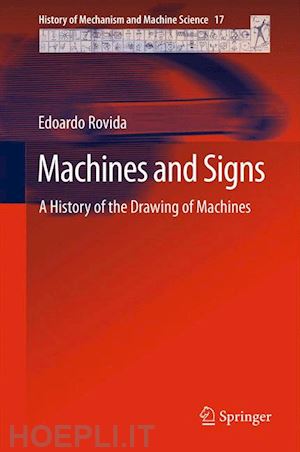
Questo prodotto usufruisce delle SPEDIZIONI GRATIS
selezionando l'opzione Corriere Veloce in fase di ordine.
Pagabile anche con Carta della cultura giovani e del merito, 18App Bonus Cultura e Carta del Docente
This volume addresses the cultural, technical and ethical motivations of the history of drawing of machines and its developments step by step. First it treats drawings without any technical character; then the Renaissance with its new forms of drawing; the 18th century, with orthographic projections, immediately used by industry; the 19th century, including the applications of drawing in industry; and the 20th century, with the standardization institutions and the use of the computer. The role of historical drawings and archives in modern design is also examined.
This book is of value to all those who are interested in technical drawing, either from an artistic, from a design, or from an engineering point of view.
1. Introduction: State of the art.- Some preliminary considerations about the history of drawing.- Conclusions.- 2. Motivation of the history of technique: Culture.- Technique.- Aesthetics.- Ethic.- 3. The first steps: Introduction.- Prehistoric Age.- Ancient times.- Middle Ages.- Conclusions.- 4. Renaissance: General considerations.- The authors.- Introduction.- Examples.- The first steps of the scientific documentation.- The first “technical” drawings.- Some conclusions.- 5. The 18th Century: Introduction.- Gaspard Monge.- The orthographic projections.- The first application of orthographic projections.- The encyclopedic books.- The drawing as didactic and popular tool.- The drawing as documentary tool for scientists.- The drawing instruments.- 6. The 19th Century: Introduction.- The first modern industries.- First steps of the institutionalized teaching.- The drawing as documentation tool for scientists.- The drawing as tool for scientific-technical divulgation.- Drawing instruments.- 7. The 20th Century: Introduction.- Drawing standards.- Historical background.- Standardization Institutions.- Drawing standards.- Development of industry.- Industries born in 20th Century.- Examples of drawings of 19th Century.- Development of technicalschools.- General characters.- Fundamental steps.- Since 1900 to 1920.- Since 1920 to 1950.- Since 1950 to 1970.- Since 1970 until today.- Application of the computer.- Drawing instruments.- 8. Archives of historical drawings: Role of archives of historical drawings.- Steps to realize an historical archive.- Examples applied to the car suspensions.- General considerations.- Structure of the data base.- 9. The critical observation of historical drawings: Technicians, engineers and designers.- Standardization organizations.- Teachers and students.- Historians.- The lesson of historical heritage.- Index.











Il sito utilizza cookie ed altri strumenti di tracciamento che raccolgono informazioni dal dispositivo dell’utente. Oltre ai cookie tecnici ed analitici aggregati, strettamente necessari per il funzionamento di questo sito web, previo consenso dell’utente possono essere installati cookie di profilazione e marketing e cookie dei social media. Cliccando su “Accetto tutti i cookie” saranno attivate tutte le categorie di cookie. Per accettare solo deterninate categorie di cookie, cliccare invece su “Impostazioni cookie”. Chiudendo il banner o continuando a navigare saranno installati solo cookie tecnici. Per maggiori dettagli, consultare la Cookie Policy.